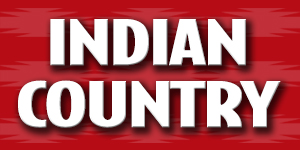Sho-Ban Tribes acknowledge Yellowstone National Park 150 years
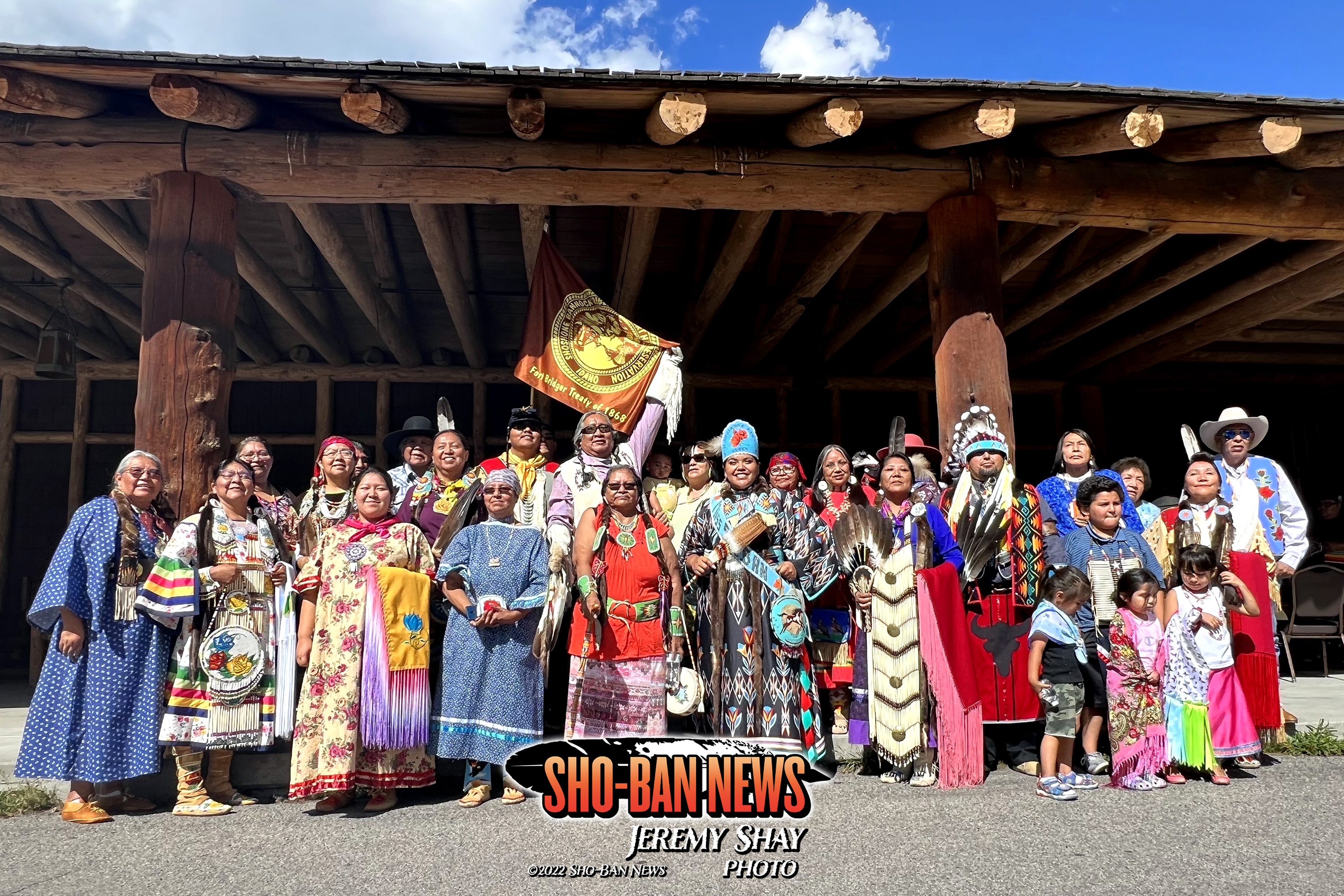
Group photo of dancers at the Yellowstone 150 event on Thursday, August 25.
By LORI ANN EDMO
Sho-Ban News
OLD FAITHFUL, Wyo. — Returning to Shoshone-Bannock homelands and appreciating the National Park Service employees for taking care of the land was a common theme of the Tribes Yellowstone 150 event August 25.
The day-long event was intended to educate the public about the Tribes homelands – its cultural and natural resource significance through a number of presentations. Fort Hall Business Council member Lee Juan Tyler opening with a prayer and song.
FHBC Chairman Nathan Small noted when coming into the park the employees welcomed him home and thanked him. “Been recognized even by the Park officials – they greet us like that – thank you National Park and everyone – welcome to the tourists.” He acknowledged the elected tribal officials present including council members and Land Use Policy Commission members.
Tyler said it was good to be there explaining his daughter and her mother’s family is part of the Yellowstone family who lived in the area prior to being removed. He said it’s beautiful country and the Tribes are part of the connection – the ecosystem. “In our homelands we want to be co-managers.”

From left, Farrell Wildcat, Lee Juan Tyler and Kevin Toane.
Claudia Washakie, FHBC secretary, explained the land’s importance to tribal people. “It’s our traditional homelands and it’s good to be here.” She said Yellowstone carries a lot of purpose, the tribal people migrated with the buffalo herds as it’s very abundant with wildlife and fish. “A lot of the places you can go to has our nanewene elements – they’re embedded in it,” such as Sheepeater Cliffs – it’s one of the places our tribal people obtained the obsidian to make flint points and tips for arrows. She hoped attendees could take some knowledge from the session.
Pat Broncho, Tribal Land Use Commissioner, said it was his first time coming to Yellowstone but he heard oral history from his grandmother who was born in the 1800s. She would tell them how they’d travel to Yellowstone to get buffalo. He said the resources are important to us and being here makes you think about the hard road they had. He’s thankful for the people who took care of the land and water.
Land Use Commissioners
Darrell Shay, Tribal Land Use Commissioner, explained his background and how the Shoshone people were all one before being broken into smaller groups. He explained how the Comanche are Shoshonean. He said the tribal people knew where the medicinal plants were and the holy land. The ground was warm so they could survive in the winter, they knew how to hunt the wild game, drive the buffalo into the buffalo jumps and get the elk in the deep snow. He said the Yellowstone area is magnetic and the tribal people gravitate to the area. “It’s so important and sacred to us – we came here to subsist, gather food and medicinal plants, the healing waters, this is our holy land and that’s why we protect it.” He said it’s not a celebration but a remembrance of this place the last group of Indians got shipped out – some went to Eastern Shoshone, Lemhi and Fort Hall – we are all related. He talked about the treaties – the Fort Bridger Treaty of 1868 and the Virginia City Treaty that was never ratified so they Mixed Bands of Shoshones, Sheepeaters and Bannocks never gave up title to the land. “Virginia City Treaty the one that identifies this location as belonging to the Shoshone, we still lay claim to it. We still own it. No one can lay claim to it,” he continued. Shay said 150 years of us being kicked out, we always snuck back in.” He said through oral history Mammoth Hot Springs is the location of the first Sundance the animals did before it was given to our people. He said one day it will come back here again. To all the tourists here, he said welcome.
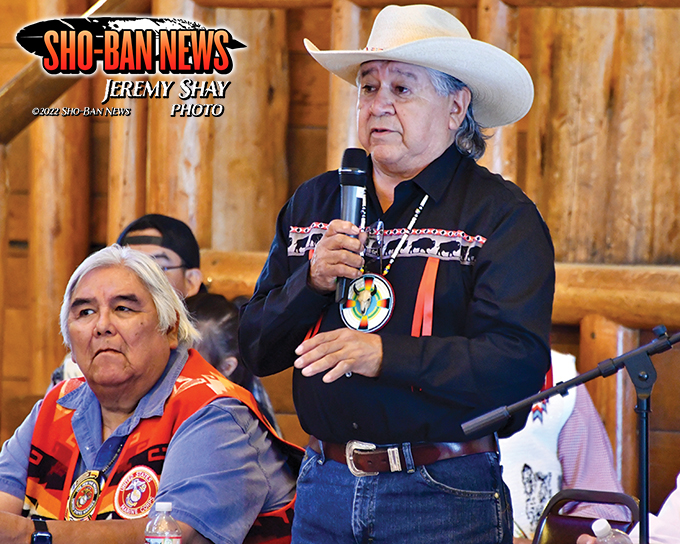
Land Use Policy Commissioner Darrell Shay speaks.
Miss Shoshone-Bannock
Kaycee Jo Dixey, Miss Shoshone-Bannock, said it feels good to be in the Tribes homeland and she’s happy the Yellowstone event is the first of her travels. She’s heard many different stories from her grandmother and grandfather about the area. She told a story about her tzo tzo Maxine Racehorse Edmo about when Maxine was a young girl she traveled with her parents on wagons to get lodgepoles to build Eagle Lodge and other lodges. Maxine told her they had to scrape the poles. That story stuck with her. “This place is very important to all of us. I’m excited to be here,” she said.
Yellowstone Superintendent
Cam Sholly, Yellowstone National Park superintendent, said welcome home – we are honored and privileged to have you back in Yellowstone. He called upon FHBC Chairman Nathan Small to the podium as he presented him with a commemorative superintendent’s medallion for the Tribes support and partnership. On the back of the coin is the last 23 bison that remained in Yellowstone a hundred years ago and now there’s over 6,000. “I call that a start,” he said but thank you for your partnership. We find it extremely inspiring to have you here for the 150th anniversary that is important not only for America, the world, we realize it has a different meaning to many of you a commemoration of an incredible place yes, an incredible national park absolutely, but the recognition that American Indians were on this landscape for over 10,000 years, before there was ever a national park concept.” “I call this day together – this week we’ve had incredible conversations and collaboration with so many tribes, not only this year but leading into this year. I call it a start – a start the park service has a major component of its mission its responsible for telling America’s stories the good and bad,” he continued. “But no one, no matter how good they are, can tell the stories of the tribes so it’s essential for multiple reasons the tribes are back in Yellowstone, educating visitors about the culture, about the history, helping us do a better as stewards of this land.” He said they’ve made progress but they have a long way to go. He said they look forward to further dialogue in the future about what is possible.
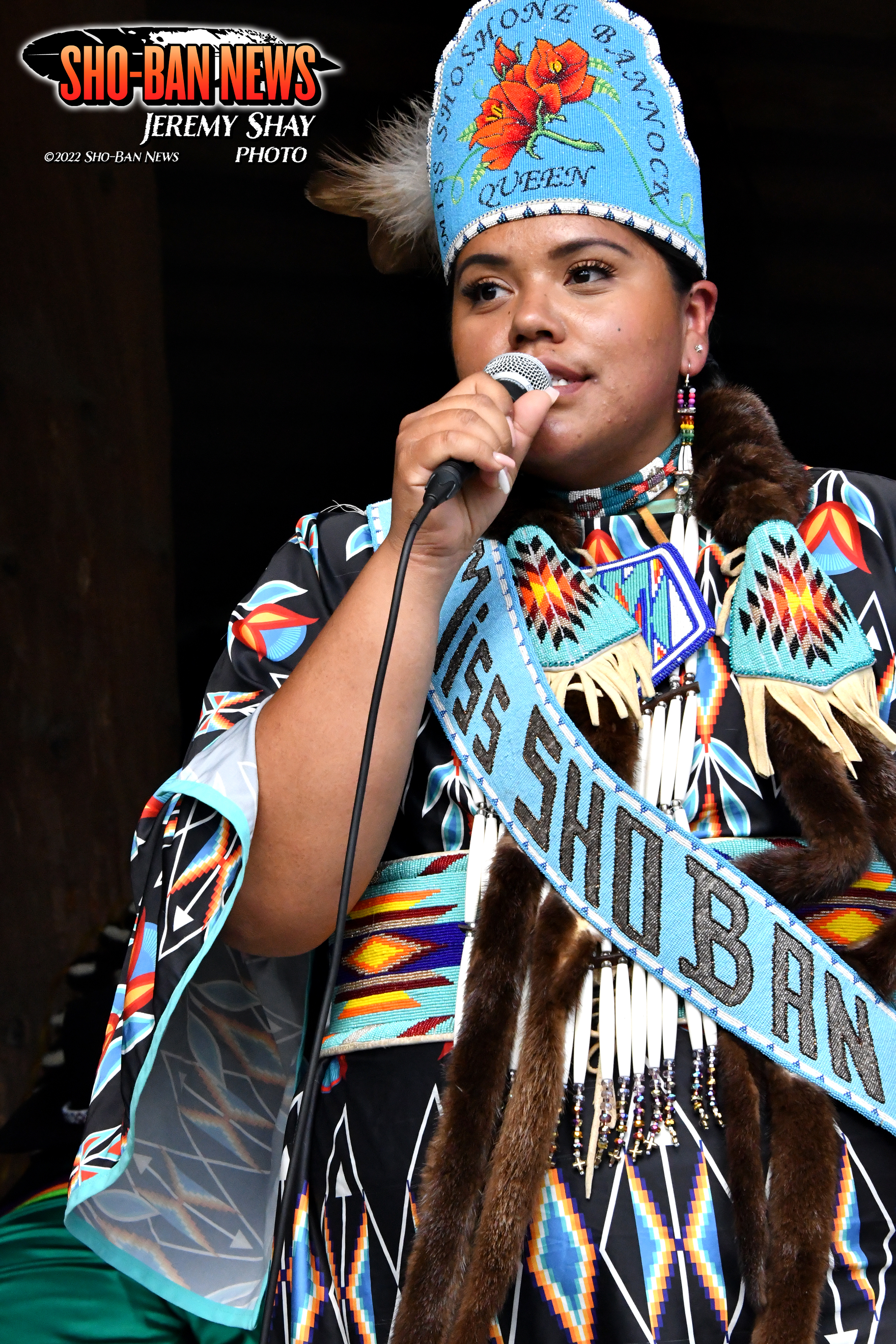
Miss Shoshone-Bannock Kaycee Jo Dixey speaks to visitors at
Old Faithful.
Fish and Wildlife
Chad Colter, Tribal Fish and Wildlife director, welcomed people to the 150 year anniversary and the Tribes homelands but it’s a bittersweet moment. It’s a remembrance of forced removal and loss of natural resources never mitigated. It can only be sweetened by the acknowledgement. From a tribal perspective it’s important to reflect where we are at and plan for future generations. He’s glad to hear Cam is open to further dialogue and it’s the beginning of a partnership that he will go on forever in his mind. Congress designated Yellowstone National Park 150 years ago withdrawing 3,472 square miles from public lands that was a good thing. It set aside the park for enjoyment and the use of the public but for the Tribes the park designation meant removal from our homelands, loss of access to Treaty reserved resources, “Treaty reserved resources that we used for subsistence for our culture to continue traditional cultural practices, all tied to this resource up here in Yellowstone,” Colter continued. “This area here is the richest most diverse part of the Snake River ecosystem, it was no longer available to support our subsistence needs, it came just three years after the Fort Bridger Treaty 1868 was ratified by Congress in 1869. Just three years later in 1872 after they secured title to all of these lands they created a park,” he explained.
Colter said he was asked to talk about the importance of preserving the park, “the greater Yellowstone ecosystem, so diverse and so rich can’t be found anywhere else in the Snake River, culturally, geologically, ecologically, hands down. Despite all the best efforts to remove the Tribes from the greater Yellowstone area, we are still here today, just look around you we are here right now. To understand the Tribes connection to Yellowstone National Park you must see it as we do, it’s our home, this is our back yard our permanent home is located here in the greater Yellowstone area just 200 miles down the road. Just type into any search engine right now – issues of Yellowstone National Park you will get a list of reputable sites and you will fully understand the current state of Yellowstone National Park as well as the greater Yellowstone area – the greater Yellowstone ecosystem.
He said climate change is a huge issue, things are going to change so fast, in just a short amount of time. Over last seven years what we’ve witnessed temperatures have changed about two degrees around here, it impacts the growing season, there’s two less feet of snowpack, we seen this year catastrophic flooding events. There are numerous other problems at Yellowstone, he continued including invasive species, mining is an issue, waiting for delisting of species like grizzly bear, migration barriers, habitation and loss of habitat, nobody wants to see grizzly bears in backyard, or buffalo but the tribes do. Tribes want to see these animals — inside the park slowly depleting bison herd, last biggest one challenge, more people that visit this park over four million cars, more than the population of three states combined. “Whose really in the zoo, I bet the animals have a different story,” Colter said. There’s a lot of issues have to tackle, partnerships coming together, removing the tribes from this ecosystem was wrong, but getting the Tries back into the ecosystem will help.It will assist with enhancing our treaty rights, natural resources and cultural resources,” he concluded.
Tom Wadsworth, Tribal Fish and Game captain, addressed Treaty buffalo hunting and said Yellowstone has always been our home. Shoshones, Bannock and Sheepeaters (Tukudika) occupied the area. Everything that is in the Park, living, show respect to that. It was about survival and availability.
He explained tribal teachings – respect, when hunting don’t take more than you need, don’t waste, treat plants with respect. He said the enactment of the Tribal Game Code was self-regulation. We have our own court system. In 1872 the tribal people were moved out of the park. Now have set reservations. The Tribes are the only tribe today that have not stopped hunting. “We never stopped hunting buffalo, deer, elk, moose around Yellowstone Park,” he continued. However some elders said they have hunted in the park. “We’re still here, this is still our home.”
In 2008, Montana recognized the Tribes right to hunt through the Treaty. “Hunting isn’t for sport, we go in and take what we need, and only what we need,” Wadsworth said. He said now in order to hunt buffalo the Tribes have to go to Gardiner basin or West Yellowstone. He said our people don’t show up in mass. Believing in culture and traditions are very important. Population and loss of herd memory have affected the buffalo. They lose the migration route. He talked about the ceremonial hunt in Jackson, Wyo. to keep our Tribes in the area to exercise our culture and traditions. Many of the photos he showed is about family. Have to hand down the teachings, he said. Style of hunting includes respect, subsistence. He explained he’s been doing the job for 27 years. He said the Tribes have to keep exercising their Treaty rights. It’s important to hunt safely. That Treaty is meant for us and have to continue protecting the right, he said. He hoped the Park Service could hear everything in the presentations and listen to the Tribes.
Fish and Wildlife Policy Analyst Dan Stone talked about Managing Yellowstone for the next 150 years. He said it’s time to look forward, “our people look to our grandchildren’s, grandchildren when we envision the future; similar to the more generic concept of the seventh generation view of life moving beyond us.” As he looks ahead to the challenges facing my home, “I can see opportunities to proactively protect both watersheds and our access to the dramatic landscapes of the Park. The previous approaches for access and resource management can be evaluated to encourage a traditional re-engagement for native peoples as a measure to restore their home.” He said through policy, “we can collectively establish permanent access and gathering measures to allow for interconnection around the Park so the Tribes are able to be in that landscape.” Finally, ensuring that the Park remains an intact ecosystem will be critical; so maintaining wet meadow habitat, managing recreational access across the Park, and rebuilding riverine processes in a changing hydrograph will increase the resiliency of the area.
Yellowstone family
Winona Tindore and Shawnie Sammaripa both descendants of Martha Yellowstone, came to speak about her and her homelands. They are the eldest and they got their teachings from her including beadwork, tanning hides and picking berries. She taught them how to help with the Sundance. Martha told them how she and her family members were born in Yellowstone. She talked about her dad Henry Yellowstone – and Henry’s Lake is named after him. Martha stayed on the north side of Yellowstone – it was warm there. Long time ago they stayed in tipis and long longhouses.
Winona was overcome with emotion talking about her grandmother. The Yellowstone family stayed in Yellowstone in the wintertime then migrated elsewhere. It was warm. She said it smelled bad.
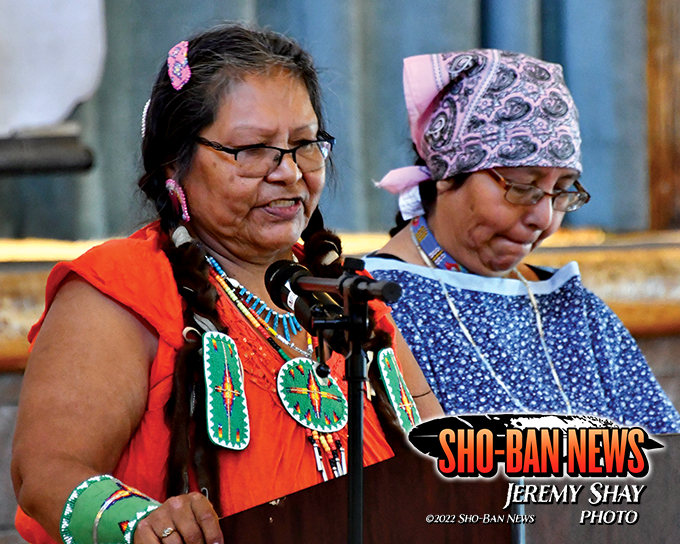
Yellowstone family descendants Winona Tindore and Shawnie Sammaripa.
Shawnie said her grandmother Martha was married to Gordon Seaman, he grandfather. When she was a little girl she would go to Martha’s house. Her memories are of beading, scraping hides, making moccasins. We feel blessed to be here today – back home in homelands. To breathe the air, the nice scenery.
Winona said they have another grandmother Alice Lincoln Charley who was also born in Yellowstone, she’s her grandmother’s cousin. She lives in Reno, Nev.
The morning session ended with FHBC sergeant at arms Gaylen Edmo who apologized for being late. He explained he got behind every slow car then went to Grant Village. He said he’s happy to be here and glad to see such good turnout. He looked forward to learning and sharing.
At the end of the day, dance exhibition was conducted where Gifferd Osborne explained the different dances and Spring Creek Singers sang.
Next week presentations during the afternoon session will be written about.




